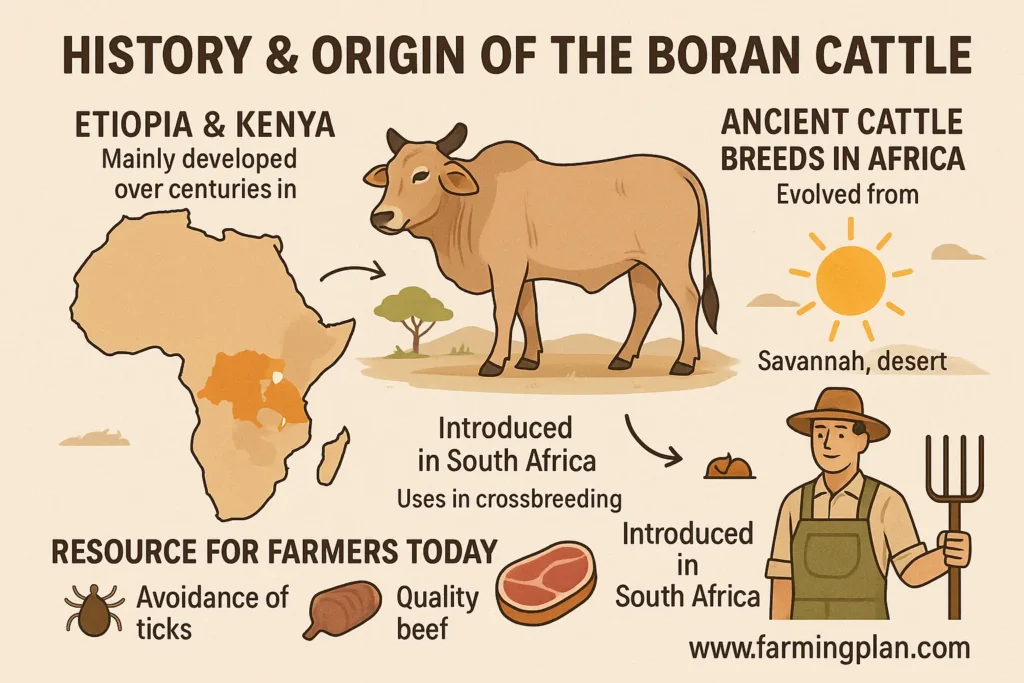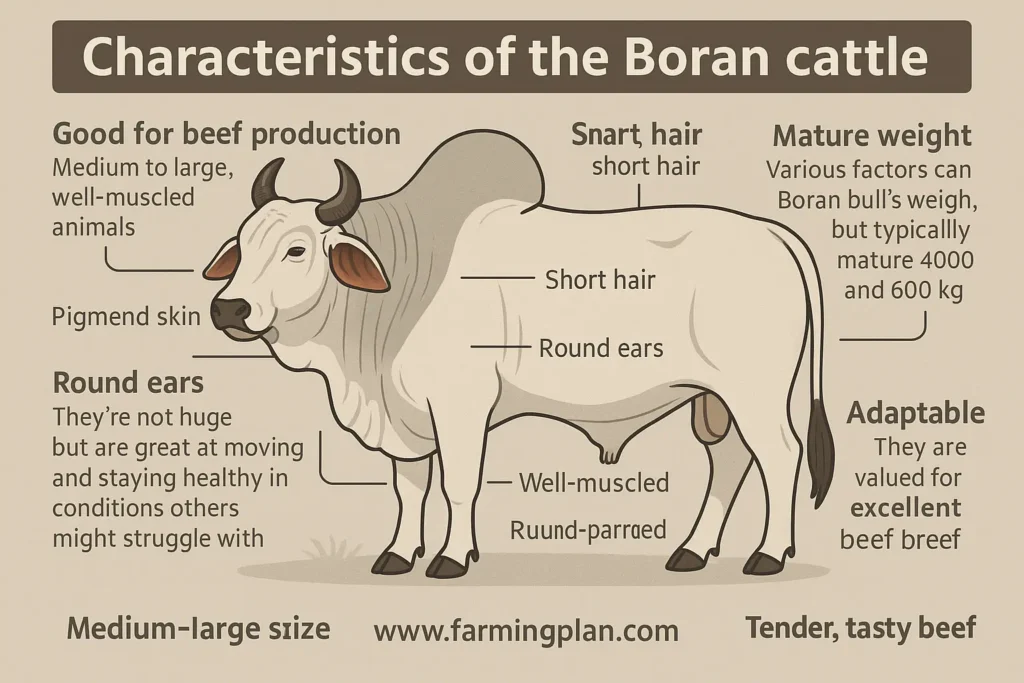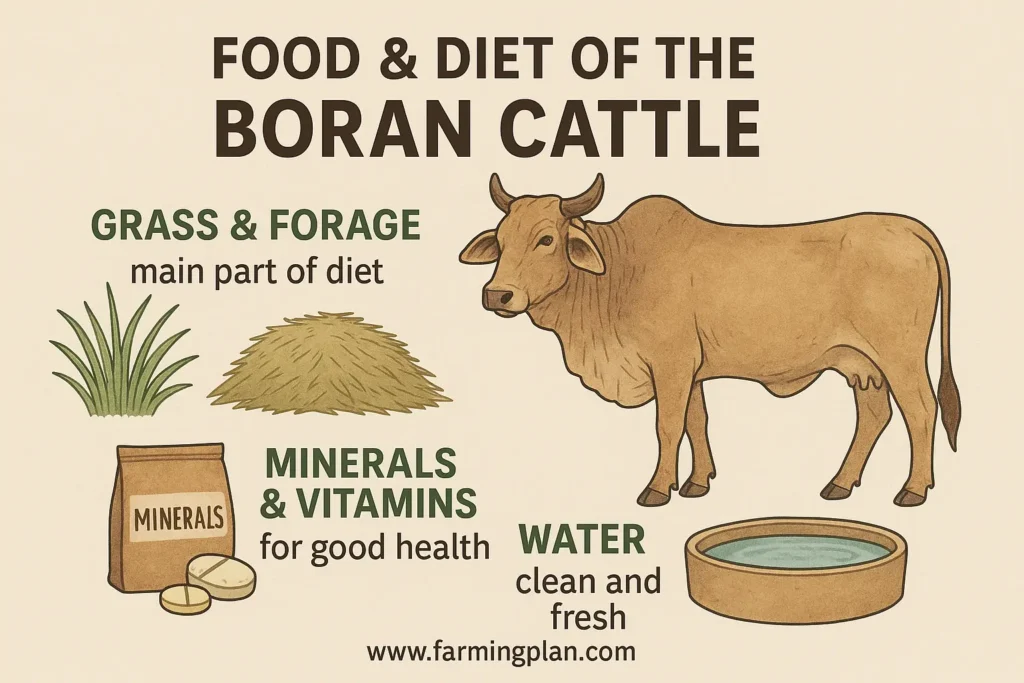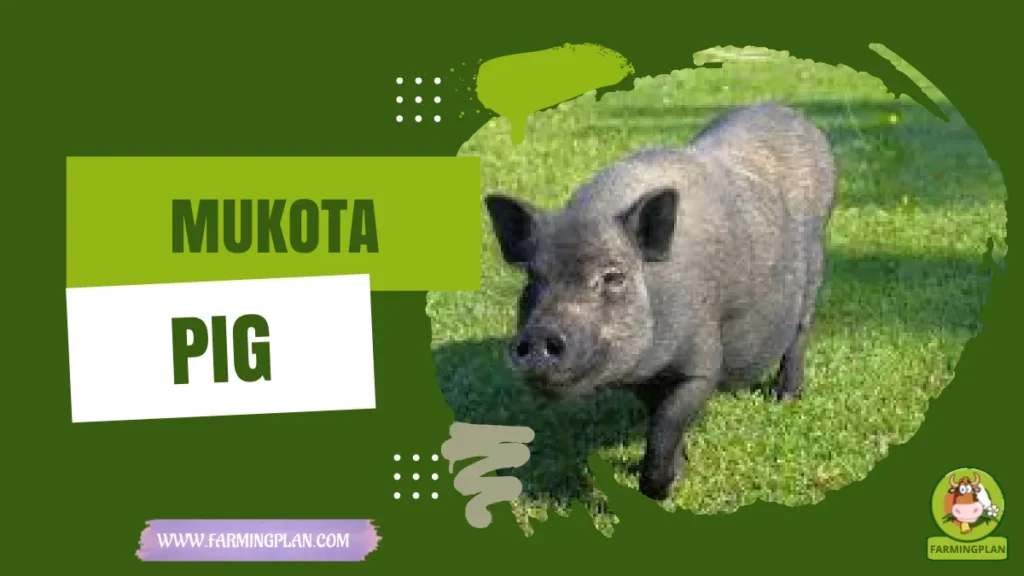These special cattle, called Boran, come from East Africa and mainly Ethiopia and Kenya and they have earned attention from farmers everywhere. Because Boran cattle can adjust to very hot weather, they are appreciated for producing both beef and milk. Thanks to their tolerance of dryness and their natural resistance to things like ticks, these animals are important members of beef cattle herds. This article will tell you about the Boran breed, where it comes from, how it looks and how best to take care of them, whether you plan to look after one or not. Let’s look into Boran cattle and find out what sets them apart!

History & Origin
Boran cattle originate from East Africa, primarily in Ethiopia and Kenya, where they were developed by the Borana people. These cattle have been bred for thousands of years to thrive in harsh environments such as the African savannah and semi-arid regions. Known for their heat resistance, drought tolerance, and tick resistance, Boran cattle were initially used for both beef production and as draft animals to help with farming.

The breed’s genetic development was driven by the need to adapt to extreme conditions, making them highly suited for arid climates and poor grazing areas. As the breed spread to South Africa, Boran cattle were used in crossbreeding programs with breeds like Brahman to create composite beef cattle, inheriting the Boran’s hardiness and the growth potential of other breeds.
Today, Boran cattle are a key part of the beef industry in both East Africa and South Africa, known for their resilience and efficiency in hot, dry conditions. Their genetic strength continues to make them a preferred choice for improving cattle genetics in tough environments.
Characteristics
Boran cattle are famous for their different physical features that draw attention when they are in a herd. Because they are medium to large, well-muscled animals, they are good for beef production. Because their coat is smooth and short, geckos can maintain their temperature in very hot climates. Pigskin may be greyish or even reddish and their big, round ears keep them cool by letting off heat.

Many factors can change a Boran bull’s weight, yet they usually mature between 400 and 600 kilograms. Even though they are not huge, they are great at moving and staying healthy in places where other breeds might struggle. Boran cattle are appreciated for their excellent beef which is often both tender and tasty. Because of these qualities, they are popular for use both nearby and around the world.
Read More: Simmental Cattle: A Breed of Dual-Purpose Cattle
Nature/Temperament of the Boran cattle
Boran cattle are known for being very calm. Because they are generally easy to manage, farmers and ranchers find it easier to care for sheep in groups. Speaking to their temper, Boran cattle are rarely aggressive which helps them adapt to both home and large professional activity.

These cattle are also highly social and prefer to live in groups. This herd-oriented behavior makes them easier to manage, as they are naturally inclined to stay together and reduce stress when in the company of other cattle.
Despite their calm demeanor, Boran cattle are resilient and can handle extreme heat and poor grazing conditions without becoming stressed. Their adaptability to tough environments, coupled with their friendly disposition, makes them an excellent choice for both small and large-scale farming operations.
Food & Diet
Boran cattle are known for their docile and calm temperament, making them easy to handle and manage. They are generally non-aggressive, which is a valuable trait for farmers and ranchers, especially in larger herds where handling can be more challenging. Their gentle nature reduces the risk of injury to both cattle and handlers.

Since they adapt to new environments, Boran cattle can get by with much less water than many other cattle types. You should make certain that your pets have enough fresh and clean water to stay hydrated when the weather is dry. Even in tough areas, Boran cattle can find enough food from the available grass.
Read More: Discover the Strength of Santa Gertrudis Cattle: Beef at Its Best
Usage/Purpose
Boran cattle are primarily raised for beef production due to their muscular build and ability to produce high-quality meat. However, they also serve other purposes on the farm. In East Africa, they are used for draft purposes, helping to pull carts or plows, especially in regions where mechanized farming equipment isn’t available.
In recent years, Boran cattle have also been bred with other cattle breeds to create composite beef cattle that inherit desirable traits such as tick resistance, heat tolerance, and rapid weight gain. This has made them even more valuable in commercial beef herds. Additionally, their milk production is an added benefit for farmers who are involved in dairy cattle welfare, with each cow yielding a moderate amount of milk daily.
Special Features
What makes Boran cattle stand out among other breeds are their unique features that help them thrive in harsh environments. The heat tolerance of Boran cattle is unparalleled in the animal world. Their ability to manage acute heat stress and continue to graze and thrive in temperatures that would cause other breeds to suffer makes them a critical asset for farmers in hot climates.
Moreover, Boran cattle have a natural resistance to ticks, which are common in many parts of Africa. This resistance means less need for costly treatments and pest management, making them a more economical choice in areas with high incidences of tick infestations. Their strong genetic makeup has made them an important part of breeding programs focused on improving cattle behavior and productivity.
Read More: Adaptaur Cattle: The Future of Livestock
Health Issues & Prevention
Like all cattle breeds, Boran cattle can be prone to certain health issues, but their resilience sets them apart. One of the most common health issues for Boran cattle is tick infestations, though their natural resistance helps minimize the impact. Cattle under tsetse challenge can face higher risks of disease, but this cattle’s resistance to these challenges makes them less susceptible than other breeds.
To keep Boran cattle healthy, it’s crucial to maintain regular vaccination schedules and ensure that they are protected from heat stress. Keeping their living environment clean and free of pests will also help prevent disease. Farmers should also monitor for any signs of reproductive issues or growth problems, as early intervention can prevent more serious health concerns.
“Boran Cattle are not just tough; they’re built for survival. Whether you’re farming in heat or cold, these cattle thrive where others fail.”
Step-by-Step Farming Guide
If you’re looking to raise Boran cattle, here’s a simple step-by-step guide to get you started:
Step 1: Set Up the Farm Environment
The first step in raising Boran cattle is creating the right environment for them. These cattle thrive in open spaces, so make sure you have enough grassland for grazing. Even though Boran cattle are heat-resistant, it’s still important to provide shade structures to protect them from extreme weather conditions. Ensure a reliable source of clean water, such as water troughs or natural water sources, to keep the cattle hydrated. Additionally, it’s essential to rotate grazing areas regularly to prevent overgrazing and maintain the quality of pastures.
Step 2: Provide Proper Nutrition
Proper nutrition is vital for the health and productivity of Boran cattle. Their diet should primarily consist of grass and forage, as they are natural grazers. During the dry season, or when forage quality is low, you may need to provide hay or silage to supplement their diet. It’s also important to provide salt licks and mineral supplements to ensure the cattle get essential nutrients. Monitor their feed based on seasonal changes to ensure they receive the proper nutrition year-round.
Step 3: Maintain Health Care
Maintaining Boran cattle’s health requires regular monitoring and care. Schedule routine vaccinations to protect them from common diseases. Even though Boran cattle have natural tick resistance, regular checks for ticks are important. You may need to use tick treatments or dips to manage infestations. Perform regular health checks to detect any signs of illness early and ensure that the cattle remain in top condition.
Step 4: Breeding and Reproductive Management
Breeding is a key aspect of cattle farming. For Boran cattle, select healthy bulls and cows with strong traits like growth and meat yield. Create a breeding calendar to ensure the cattle have proper recovery time between breeding cycles. If you want to improve specific traits in your herd, consider using artificial insemination (AI) to bring in superior genetics. Make sure your breeding stock is in peak health before breeding to ensure a successful outcome.
Step 5: Herd Management and Welfare
Managing the herd involves organizing the cattle by age, sex, and health to ensure good herd dynamics. Boran cattle are social animals and should be kept in manageable groups to minimize stress. Regularly rotate the grazing areas to prevent overgrazing and ensure that pastures are kept in good condition. Regularly monitor the herd for signs of stress, illness, or injury, and address any issues quickly to maintain a healthy and productive herd.
Step 6: Record-Keeping and Financial Management
Proper record-keeping is essential for tracking the health and productivity of your Boran cattle. Maintain records of each animal’s health, growth, and productivity to make informed decisions about breeding, feeding, and health care. Additionally, keep track of your expenses (feed, veterinary care) and income from beef or milk production. Using farm management software can simplify the record-keeping process and help you monitor both the health of the cattle and the financial success of your operation.
FAQ
What are Boran cattle used for?
Boran cattle are primarily used for beef production but can also be raised for dairy and draft purposes in some regions.
How much milk do Boran cattle produce?
On average, Boran cows produce a moderate amount of milk per day, making them suitable for both meat and milk production.
Are Boran cattle heat-resistant?
Yes, Boran cattle are highly heat-resistant and thrive in hot climates, making them ideal for arid conditions.
How much do Boran cattle weigh?
Adult Boran cattle typically weigh between 400 to 600 kilograms, depending on their age and condition.
Where can I buy Boran cattle?
You can find Boran cattle for sale from local breeders in East Africa and South Africa, or through online cattle auctions.
Conclusion
Boran cattle are a resilient, adaptable breed that excels in challenging climates, particularly in hot and arid environments. Their unique traits, such as heat resistance, tick resistance, and excellent beef production, make them a valuable asset for farmers worldwide. With proper care and attention, these cattle can thrive in a variety of farming conditions, providing both meat and milk. If you’re considering adding Boran cattle to your farm, their hardiness and productivity will make them a worthy investment.


